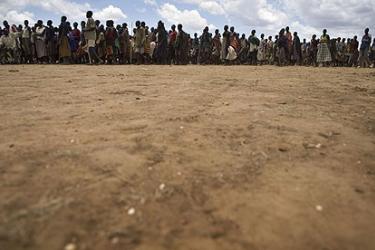> Ñlimate Change & Population
People, Population, and Climate Change: Opportunities for Advancing Climate Resilience and Reproductive Rights
by Sarah Fisher and Karen Newman, Population and Sustainability Network
|
This fall, the world population will reach 7 billion people at a time of accelerated environmental disruption. This article part of a series commissioned by RH Reality Check to examine the causes and consequences of population and environmental change from various perspectives and the policies and actions needed to both avoid and mitigate the inevitable impacts of these changes.
|

|
Introduction
The relationship between population and climate change raises a number of complexities and sensitivities, which mean that linking the issues is associated with much controversy, and is often shied away from. In this article we explore the many critical links between population, sexual reproductive health and rights and climate change, the significance of which is all too important to ignore. Not least, this is because a focus on the connections between population dynamics and climate change offers considerable opportunities to increase the capacity of the countries most vulnerable to climate change to adapt to its impacts, at the same time as advancing sexual and reproductive health and rights.
Global population growth and unmet need for family planning
According to the latest UN population projections, the world population which was set to reach 7 billion this year, is now expected to exceed 9 billion by 2050 and to surpass 10 billion by the end of the century. The vast majority of this growth will take place in developing countries, particularly in many of the poorest nations of the world, including Sub-Saharan African countries. The rate of population growth in these countries is so high that the population of the 58 nations classified as ‘high fertility’ countries by the UN is set to more than triple between now and 2100, along with the entire population of Africa. With these countries already struggling to lift millions out of poverty, such rapid population growth will place even greater constraints on development, at the same time as these countries face the challenges of adapting to climate change.
Worldwide there is a vast unmet need for contraception, which as for population growth is concentrated in the poorest countries of the world, a point which is of course not unrelated. An estimated 215 million women in developing countries have an unmet need for contraception, meaning that they are at risk of pregnancy and say they do not want to have a child during the next two years, but are not using contraception. The reality of this situation is that women in developing countries are not able to choose to plan and space their children. While the scale and rate of population growth projected by the UN for this century is alone a cause for concern, even more worryingly the projections are based on the assumption that future fertility in the high-fertility countries will drop significantly: from the current 4.9 children per woman to 2.1 by the end of the century. To achieve such reductions, it is essential that access to family planning expands, yet since the mid-to-late 1990s, donor investment in family planning has decreased dramatically in absolute terms. As a result many countries where women have a high unmet need for contraception have experienced considerable declines in family planning assistance, at the same time that demand is increasing.
Climate change: it’s happening now
While some scepticism about climate change persists, the message from the Intergovernmental Panel on Climate Change (IPCC) is clear: climate change is already happening, and as a result of human activity. Increased energy consumption during the 20th century has caused the build-up of greenhouse gases (GHG) in the atmosphere which result in warming of the earth’s surface. Warming over the 100 year period prior to 2006 was 0.74°C, with most of the warming having occurred in the past 50 years. Global GHG emissions are expected to continue to grow over the next few decades, causing further warming and changes to the global climate system, and on a greater scale than previously. Based on climate change models considering six different emission scenarios, the IPCC reports that global temperatures are likely to rise between 1.1°C and 6.4°C by 2100, with best estimates between 1.8°C and 4°C. To put this into perspective: a rise of over 2°C above pre industrial average temperature is considered the level at which dangerous climate challenge poses a risk to all, not just the most vulnerable. Furthermore, global GHG emissions are rising faster than the most dire of the emission scenarios. What does this really mean?
We have already experienced a sea level rise of over 4cm, and sustained global temperature rises of 5–6°C could raise sea levels by up to 13 m by the middle of the next century. With a third of the world’s population living within 60 miles of a shoreline and 13 of the world’s 20 largest cities located on a coast, hundreds of millions could face environmental mass migration. The impact of sea-level rises will be greatest in densely populated low-lying river deltas. In Bangladesh for example, a 1 m rise will mean 20 percent land loss and displacement of 15 million people. Worldwide, increased frequency and intensity of floods, droughts and other extreme weather events is likely to expose hundreds of millions of people to increased water stress and food insecurity. The health and well being of billions of people will be at risk from impacts upon food and water security and changing patterns of disease. What’s worse is that it is the least developed countries that have contributed the least to climate change which are the most vulnerable to its impacts, and have the fewest resources available to them for climate change adaptation.
Population and climate change: a complex relationship
Population issues can be linked to climate change in two important and distinct ways. Climate change mitigation refers to lessening the impacts of climate change by reducing GHG emissions. Adaptation refers to responding in ways to reduce vulnerability to its impacts. Research over the last decade shows that population growth has significant implications for both climate change mitigation and adaptation, pointing to the positive role that increased investment in voluntary family planning could play in response to climate change. Yet discussion of the relationship between population dynamics and climate change has been largely absent from the international climate change agenda to date. This is in part because of the complex and sensitive nature of the links, relating to the uneven global distribution of the GHG emissions, as well as different patterns of demographic change.
The key driver of climate change is the high levels of GHG emissions by the developed world, where population growth is not for the most part, a major issue. In contrast, the vast majority of population growth is taking place in developing countries where average consumption and GHG emission rates are far lower. But due to both geographical factors and resource constraints it is these countries that are at greatest risk from climate change. Furthermore, population growth in these countries increases climate change vulnerability and makes adaptation difficult, with population and climate change placing a double burden on natural resources. Intensifying the relationship, other demographic variables, including population density, migration, household composition and urbanisation, have additional implications for climate change mitigation and adaptation. Confounding matters further, the legitimate development aspirations of countries in the global South will inexorably result in increased emissions. For although we talk about ‘low carbon growth’, we don’t know what that looks like in practice; development patterns to date have been characterised by significant increases in per capita emissions.
Population and climate change: a controversial link
Although population growth is identified by developing countries as a factor undermining national climate adaptation efforts, it is not easy to position increased investment in family planning as an important strategy in the face of climate change. As long as the industrialised global North fails to take the action necessary to cut dramatically its GHG emissions, advocating reduced population growth in the South risks appearing to blame climate change on that growth, instead of recognising that responsibility for this lies largely with Northern countries while it is those in the South that will suffer the most . Furthermore family planning is of course itself a contentious issue, and one which remains blighted by the history of coercive programmes of the ‘60s and ‘70s which were not managed in ways that respected and protected the needs and interests of women. This was a mistake that absolutely cannot and must not be repeated. It is essential therefore that any efforts to link population and climate change fully acknowledge and respond to the many associated complexities and sensitivities, and advocate clearly that coercive family planning programmes have no place in international development programmes.
Population and climate change: a critical connection
While developed countries deliberate over the ethics of linking population to climate change, developing countries are themselves identifying the negative ways in which the interaction of population dynamics and climate change is exacerbating their vulnerability and undermining adaptation. As part of the UN Framework Convention on Climate Change the 40 least developed countries in the world have produced National Adaptation Programmes of Action (NAPAs), in which they outline their top priorities for adaptation and specific local climatic vulnerabilities. In these reports, 37 least developed countries (93 percent) identify rapid population growth as making coping with climate change more difficult. Population growth is identified as increasing demand for key natural resources such as land and water, acting in tandem with climate change to deplete these resources, and heighten vulnerability by forcing people to migrate to more environmentally fragile areas. Frequently mentioned climate change adaptation issues exacerbated by population growth include: soil degradation and erosion, fresh water scarcity, migration, deforestation and shortages of farmland. Additional vulnerabilities linked to population growth include loss of biodiversity, diminishing fish stocks and constraints on health services. These issues have considerable implications for agriculture, food security and health, as well as for conflict fuelled by competition for natural resources.
Turning to the issue of mitigation, the potential for a focus on population to benefit climate change mitigation is less straight forward, and indeed more controversial, but still warrants attention. With the vast majority of population growth taking place in countries where per capita consumption levels are relatively extremely low, there is concern amongst many environmentalists that focusing on population distracts from the urgent action industrialised nations must take to tackle their inequitable and unethical patterns of consumption. Unmistakably, dialogue on population and climate change must encompass wider policy issues, including the causes of climate change and associated responsibilities of the global North. Yet given the scale of the threat posed by climate change, we need to move beyond simplistic either/or approaches. Instead we must embrace the full range of strategies available to support the countries most vulnerable to climate change to adapt, as well as to lessen the impacts in the future.
The global population pathway, alongside technological change, social and economic development and changing patterns of energy and land use, has been shown by the IPCC to be a critical factor determining the course of future GHG emissions. This is reflected in recent research estimating that a lower population path could provide 16-29 percent of the emission reductions necessary to avoid global warming of more than 2°C by 2050. While per capita emissions are far lower in developing countries, between now and the end of the century the population of less developed regions of the world is projected to increase by over 3 billion. This will inevitably result in increased GHG emissions, alongside those linked to the economic growth that will be promoted in these countries in order to achieve the necessary development and poverty alleviation. The right of these countries to develop must be recognised by international climate change policy, and responding to the resultant increased per capita emissions, the emissions of the developed world must significantly contract in return.
On the issue of unequal consumption rates in the global North, inequitable consumption rates are such that preventing one unplanned pregnancy in an industrialised country will have a far greater impact than preventing an unplanned pregnancy in the global South. Comparing carbon dioxide emissions in the US and India for example, the average person in America is responsible for over sixteen times that of the average person in Indian. The links between population growth, climate change and achieving universal access to family planning must therefore not be seen as relevant only in the global South. Furthermore, in both the North and the South consideration should also be paid to the significance of other demographic variables. Urbanisation and ageing for example have implications for emissions due to effects of economies of scale for energy use and differing energy consumption patterns. While these factors will influence emissions, the full extent to which they will shape emissions outcomes is not yet known.
An integrated and rights-based approach is needed
A focus on population dynamics offers such potential to further international response to climate change that it is time population commanded the consideration necessary, and crucially, in ways that advance sexual and reproductive health and rights. Women with an unmet need for effective contraception are estimated to account for 82 percent of all unintended pregnancies in developing countries, contributing significantly to population growth. This means there are real opportunities to reduce population growth in these countries, simply by preventing unplanned pregnancies, and bringing closer the day when every child is a wanted child. What is required is the political will to enable all women and men to have the access to family planning that is often taken for granted in the developed world. While the importance of family planning for women and children’s health and women’s rights alone should be more than sufficient to generate the necessary investment to achieve universal access to sexual and reproductive health services, sadly this has not been the case. Climate change however, offers yet another reason why ensuring all women have access to family planning makes sense, and one that might just yield more of the attention it deserves.
The critical nature of the links between population dynamics and climate change mean that it’s not a case of whether this will become more widely recognised, but when. For precisely this reason, those of us who care about women’s rights and sexual and reproductive health and rights need to be fully involved in the debate: so that programmes relating to population issues respect and protect these rights. A rights-based approach is essential to addressing the inter-related problems in the global South of high fertility rates, sustained poverty and vulnerability to climate change. With a central focus on choice, this approach would offer access to family planning services as part of comprehensive sexual and reproductive health services. It would address the large unmet demand for reproductive health services and choices, but encompass far more. A rights-based approach includes addressing issues such as sexual violence and coercion, and other interventions that seek to promote behaviour change through changing the social norms underlying gendered power inequalities. There is also a focus on education strategies that encompass rights-based ethos within programmes to increase people’s understanding of rights and instill a sense of entitlement. Lastly, a rights-based framework establishes means for ensuring accountability and for redress of rights violations.
Advancing a rights-based vision
To succeed in promoting an integrated population and climate change agenda as a legitimate part of a global response to climate change, a language must be found that reflects and addresses the need to emphasise resource consumption in the North, at the same time as advocating increased access to sexual and reproductive health care services in the South. We must be absolutely clear that our primary motivation is the welfare of citizens in the countries most affected by climate change, and that it is the developed world that must shoulder the responsibility for reducing GHG emissions. For climate change mitigation, tackling over-consumption of resources by the developed world is the most critical strategy, though population dynamics are relevant and must be one of the many approaches we need to drawn upon given the enormity and complexity of the challenges we face. For climate change adaptation, we must listen to the very real concerns and experiences being voiced by developing countries about the ways that population growth is heightening their vulnerability to climate change and undermining adaptation.
Universal access to reproductive health, irrespective of the opportunities it offers to reduce climate change vulnerability, is a basic human right which cannot be achieved without increased investment in the necessary services. Funding must be made available for the integration of rights-based reproductive health programmes into adaptation strategies, including through climate change funding streams. Women’s choices, needs and rights must be at the centre of these programmes. Rather than ignoring the ‘population issue,’ governments and donors must be called upon to embrace rights-based approaches to reproductive health as part of wider development goals, including climate change policy. We must emphasise the ‘win-win’ nature of this approach: securing reproductive health and rights while increasing climate change resilience in the countries which are at greatest risk, despite having contributed to climate change the least. Achieving this vision is both a matter of reproductive justice and climate justice.
Source: RH Reality Check - Reproductive & Sexual Health and Justice
<< Previous page
---
Next page >>
TOP
|




